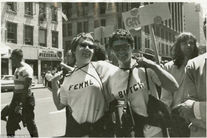... for Bruce?
In 1952, when Bruce was 16 years old, the American Psychiatric Association listed homosexuality in the Diagnostic and Statistical Manual (DSM) as a mental disorder. It stayed in the DSM until 1972. The atmosphere of the 1950s was exceptionally conservative, focused on staving off communism. As a young gay man, reaching sexual maturity in the 1950s must have been stifling.
The 1950s were also the era of the lavender scare, in which suspected gay and lesbian people were fired for government positions because their "perversions" made them "easily bribed" and "unfit to serve." The lavender scare continued until 1965, and it remained legal to refuse employment based on sexual orientation all the way up until 1995. As an intellectual, Bruce seemed to value his job. If Bruce had been exposed as a gay or bisexual man in his lifetime he could have been treated for a non-existent mental illness, fired from his job, and stripped of the respect of his community. It would have taken a great deal of courage to come out.
The gay community wasn't completely underground in Bruce's time. At the end of the 1960s and into the 1970s gay bars became commonplace, especially in big cities. Most cities also had public bathhouses or athletic clubs that were either exclusively homosexual or were discreetly “cruisy.” In the early 70s, the gay community was more sexually advanced than the hetero community. Members of the gay community experimented with sex outside of the socially acceptable boundaries, because their sexuality alone was already socially unacceptable. This added further fuel to the fire that homosexuals were 'sexually deviant.'
It should be noted that Bruce never did come out. Alison speculates that he might have been homosexual, or he might have been bisexual, yet Alison's sister-in-law insists Bruce was heterosexual. Because he was not given the freedom and support he needed, we will never know Bruce's sexuality, and perhaps it's none of our business.


... for Alison?
When Alison was growing into her sexuality it was a very different time. The Stonewall riots of 1969 had started a passionate movement to bring gay culture into the limelight. The gay rights movement brought with it a sense of pride for the gay community. The term "gay pride" was coined in 1970. The committee tossed around the idea of calling the movement "gay power" but they decided before they could have power they needed to have pride. I think this idea of pride is a very important difference between Alison and her father. Alison learned to be very proud of who she is, but her father was always ashamed, at least that's the way Alison saw it.
The fight for equal rights and social respect for lesbians presented its own unique challenges. In the early 20th century gay men were viewed as criminals, while lesbians were viewed as 'immature' girls who would grow out of their 'deviant' desires when they entered into a heterosexual marriage. Lesbians had to fight for their sexuality to even be recognized. Lesbians were virtually ignored until they piggybacked off the feminist movement of the 1970s.
The feminist movement was booming in the 1970s. The National Organization for Women (NOW) was founded in 1966, and by the 70s they were focused on "consciousness-raising." Consciousness-raising began with the goal to help women understand how a patriarchal society abused women, marginalized them, stunted their personal growth, and limited their lives. The movement quickly evolved from 'women are mistreated by men' to 'women are equal to men.' This was a revolutionary idea.
The 80s were a time of massive progress in the LGBT fight for equal rights, but there were still many setbacks. In 1986 in the court case Bowers vs. Hardwick the supreme court ruled that there was no fundamental right to be gay. This same court case upheld the ruling that sodomy was a felony punishable by up to 20 years in prison. This ruling sparked an LGBT movement called the Privacy Project which sought to irradiate sodomy laws on a state by state basis.
When Alison was exploring her sexuality, she was met with a community full of pride and the will to enact social change. It's amazing how much things change in a single generation.












